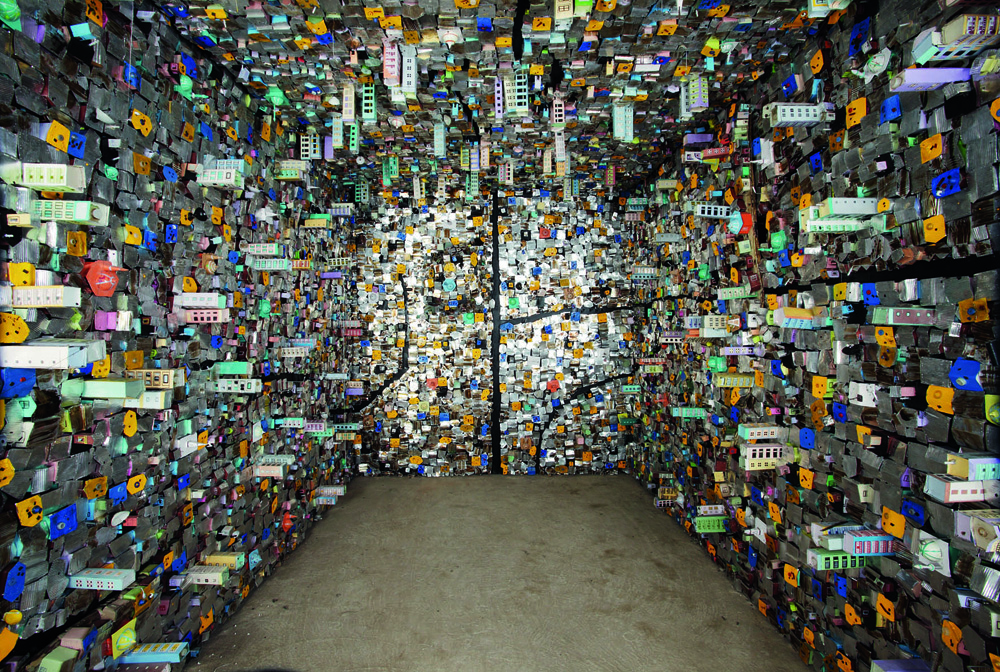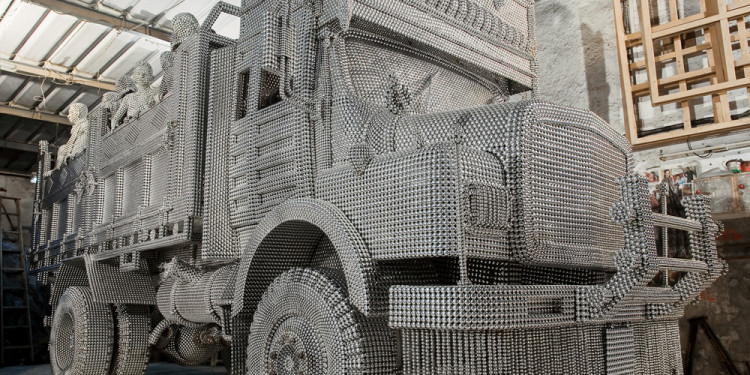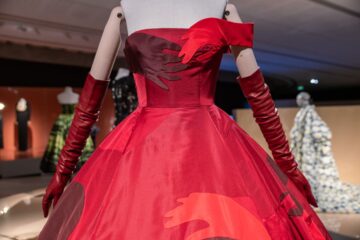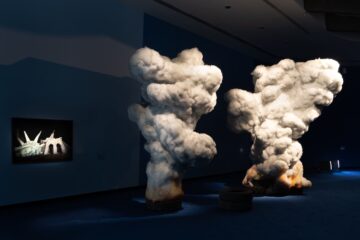INDIAN HIGHWAY – NATIONAL MUSEUM OF 21st- CENTURY ARTS – MAXXI, ROME


Text by Vittoria Biasi – translated by Salvatore Rollo. All Texts are 1F mediaproject copyright. All Rights Reserved.
INDIAN HIGHWAY
September 22, 2011 – January 29, 2012
NATIONAL MUSEUM OF 21st– CENTURY ARTS – MAXXI, ROME
www.fondazionemaxxi.it
It has been a long wait and aroused curiosity into the western sensitivity both for the philosophical- cultural debate with the East and for the prestigious exhibition’s route that from the London Serpentine Gallery and Oslo Astrup Fearnley Modern Art Museum will get to MAXXI in Rome where from here it will leave to New Delhi for the edition of 2013.
The exhibition Indian Highway, edited by Julia Peyton-Jones, Hans Ulrich Obrist, Gunnar B. Kvaran and Giulia Ferracci, for the MAXXI, in coproduction with the Serpentine Gallery of London and the Astrup Fearnley Museum of Oslo, organized by MAXXI Art, proposes 30 artists exhibiting 60 works of which 4 are site-specific installations.
The exhibition, as worded by the title, offers a reading of the large Nation’s history. Anna Mattirolo Director of MAXXI ART says “Indian Highway starts from an idea of highway as a connecting element among the migratory flows moving from periphery to town, shows the increasing world centrality of the Indian civilization through the works exhibited, even under an artistic viewpoint as from the nineties till our days.

Starting from a highway, from a main artery of communication from where they radiate and to which flow all the forms of life, the artists show the India circulation of a macroeconomic system as seen from above.
The exhibition is articulated following four points: the migratory flows from edges to town; the technological development, the economic boom; the centrality of the continent in the world situation. The impact with the exhibition wealth begins on the second floor with the monumental Valay Shende‘s sculpture “TRANSIT”; it is a lorry with passengers standing on the exposed back. The whole work made of aluminium rods, hints at the humble life that from the countryside move to reach their workplace using means by chance.
Valay Shende enshrouds the sense of rituality of his own culture into the poetic mythology of the metallic light, in the rawness of the daily terms. The works exhibited on second floor large rooms tell us the identity of the Indian thought whose life elements are just passages, for good or ill. The Shifta Gupta’s installation “Untitled–Skewers” is made of 185 lances hanging from the ceiling. They are gathered up in a shape remembering the large chandeliers that scan, refract light and excite admiration for splendour and brightness. The artist upsets the visual process of “westernized” mind and proposes terrible units like the lances that all together reveal “our ontological conceit” as it could be said by Nicolas Bourriaud. The works are shown following a thematic way and throughout the narration there are Jitish Kallat’s Autosaurus Tripous, a car-rickshaw whose sculptural skeleton is made by resin bones, “divine harmony” quotation, that rickshaw by push or bike drivers show through their body to recall Mahatma Gandhi’s speech delivered to his people and copied by the artist with about 4500 fibreglass bones; the triptychs Baggage Claim of Jitish Kallat, where underprivileged and pariah run around a desolate place where the flies are painted by the hyper realistic artist on scale similar to the wrecked car.
The mystery of nocturnal Indian spaces is recreated by Dayanita Singh through the works Red Forest, Dream Villa 20, Dark tent, Blue forest, meanwhile Ashok Sukumaran and Shaina Anand pick up and organize the news coming from open space net in “Lossfulness”. The concept of space as time, simultaneity and diversity is coped by Shilpa Gupta in the conceptual work In Our Times: in a secluded space, a horizontal bar, equipped with a mike at both ends, stands on a upright bar creating an up and down motion between 1947 Muhammad Alì Jnnah’s speech (Presidential Address to the Pakistan Constituent Assembly) and Jawaharlal Narhu (Speech on the Granting of Indian Independence).
The different visions or readings of the Indian culture got the issue in the scents of earth through the work of Hemali Bhuta who makes a barrier with joss-sticks which transform the sensory impressions of the place.
This is referable to the poetry of Jannath Panda in “The Sound of spectacle I” that paints on canvas an animal world merged with the vegetal through transfigurations from a trunk to an enchanted and sad eyes deer.
The artist uses damask fabrics, velvets embroidered with thin silver threads to create the light coats of the fishes, precious symbol, guidance for the Oriental cultures.

The exhibition is made of works leading into the Indian mysticism and daily life. Suboth Gupta shows an installation of 27 metres made of trays and kitchenware (tiffin box), arranged in succession like books in a bookshelf. The bright steel work is strong and memory fascinating; about the idea of strength that connotes the workers during some historic period of man all over the world. In India, the poor’s social drift render up them repository of traditions, of past memories. The transformation of towns and societies assumes in the East another overtone due to the daily contact between present times and the past. The language of Subodh Gupta hints at Hindu cuisine that is very important, as said by the artist, it is pure, strictly correlated to the place of worship. The artist extends the custom of the private tie with the food, he makes it a museum piece like a shrine. Beside to some social class drift we witness the transformation of new middle class that perhaps is participating the country’s economic boom. Subodh Gupta shows the objects of the new Indian middle class in “Take off your shoes and wash your hands”. Meanwhile Sheela Gowda in “Dark Room” displays attention for the reject items she chooses and uses depending on their symbolism; she transforms tar-bins coming from road yards into fortress-buildings.
The Indian mysticism is spread over the exhibition and in the Desire Machine collective (Sonal Jain, Mriganka Madhukaillya) that have got the sounds coming from Law Kyntang Holy Forest, in the scents present along the corridor that Sumakshi Sing changed in a poetic place named “Circumference Forming”, like a collection of the uppermost expressions of art with pictures cut out from history books and applied on the walls decorated with colours and lines suspended between true life and illusion. The exhibition is dedicated to the Indian artist Fida Husain, lately dead, protagonist, after the English colonialism, of the artistic Indian scene
Vittoria Biasi
Art historian, critic and curator of international exhibitions
translated by Salvatore Rollo
Artists:
Ayisha Abraham (London, 1963); Ravi Agarwal (New Delhi, 1958); Sarnath Banerjee (Calcutta, 1962); Hemali Bhuta (Mumbai, 1978); Nikhil Chopra (Calcutta, 1974); Desire Machine Collective (Sonal Jain, Shillong 1975 and Mriganka Madhukaillya, Jorhat 1978); Sheela Gowda (Bhadravat, 1957); Sakshi Gupta (New Delhi, 1979); Shilpa Gupta (Mumbai, 1976); Subodh Gupta (Khagaul, Bihar, 1964); N.S. Harsha (Mysore, 1969); Abhishek Hazra (Calcutta, 1977); M.F. Husain (Pandharpur 1915-London 2011); Jitish Kallat (Mumbai, 1974); Amar Kanwar (New Delhi, 1974); Bharti Kher (London, 1969); Bose Krishnamachari (Kerala, 1963); Nalini Malani (Karachi, 1946); Jagannath Panda (Bhubaneshwar, 1970); Prajakta Potnis (Mumbai, 1980); Raqs Media Collective (Jeebesh Bagchi, New Delhi 1965); Monica Narula (New Delhi, 1969); Shuddhabrata Sengupta (New Delhi, 1968); Tejal Shah (Bhilai, 1979); Valay Shende (Nagpur, 1980); Dayanita Singh (New Delhi, 1961); Sumakshi Singh (New Delhi, 1961); Kiran Subbaiah (Sidapur, 1971); Ashok Sukumaran and Shaina Anand (A.S., Japan 1974); Thukral & Tagra (Jiten Thukral, Jalandhar 1976); Sumir Tagra (New Delhi, 1979); Hema Upadhyay (Baroda, 1972).
Last of all the show Nineteen Mantra will be on stage in the Auditorium “Parco della Musica” and then in Milan during January 2012. It is a spectacular video musical that, through mantra verse, tells the enthusiasm for the myth transposing it into the contemporaneity. The work is anticipated in the exhibition by three multimedia stations.
The project was planned for MAXXI Art, produced by Fondazione Musica per Roma and MAXXI Foundation; it was coproduced with Teatro alla Scala Academy; the executive production was of Fattore K directed by Giorgio Barbiero Corsetti. Music by Riccardo Nova; choreography of Shantala Scivalingappa with the contribution of dancers, musicians and Indian singers.

Indian Highway
22 settembre 2011 – 29 gennaio 2012
Museo nazionale delle arti del XXI secolo – MAXXI, Roma
www.fondazionemaxxi.it
Testo di Vittoria Biasi – Copyright 1F mediaproject.
E’ stata molto attesa ed ha suscitato curiosità per la sensibilità occidentale verso il confronto filosofico-culturale con l’oriente e per il prestigioso percorso dell’esposizione che, dalla Serpentine Gallery di Londra e dal Museo d’arte Moderna Astrup Fearnley di Oslo in Norvegia, giunge al MAXXI di Roma da dove partirà per l’edizione del 2013 a New Delhi.
La mostra Indian Highway, a cura di Julia Peyton-Jones, Hans Ulrich Obrist, Gunnar B. Kvaran e Giulia Ferracci per il MAXXI, realizzata in coproduzione con Serpentine Gallery di Londra e Astrup Fearneley Museum di Oslo e organizzata dal MAXXI Arte, propone trenta artisti, che espongono 60 opere tra cui 4 installazioni site specific.
La mostra, come enuncia il titolo, offre una lettura della storia del grande paese. “INDIAN HIGHWAY al MAXXI – dice Anna Mattirolo, Direttore MAXXI Arte – partendo dall’idea dell’autostrada come elemento di connessione tra i flussi migratori che si spostano dalla periferia alla città, testimonia attraverso il percorso espositivo la crescente centralità mondiale della civiltà indiana, anche dal punto di vista artistico, a partire dagli anni Novanta fino ai nostri giorni”.
Quasi partendo da un’autostrada, da un’arteria principale di comunicazione da cui si diramano e in cui confluiscono le diverse forme del vivere, gli artisti presentano un’India vista dall’alto, nella circolazione di un sistema macroeconomico. L’esposizione è impaginata su quattro punti: i flussi migratori dalla periferia alla città, lo sviluppo tecnologico, il boom economico, la centralità del continente nel panorama mondiale. L’impatto con la ricchezza espositiva inizia al secondo piano con la scultura monumentale Transit di Valay Shende, che è un grande camion con passeggeri in piedi sul retro scoperto. L’opera, totalmente realizzata con tondini di alluminio, allude alla vita dei semplici che dalla campagna si spostano per raggiungere i posti di lavoro utilizzando mezzi fortunosi. Valay Shende avvolge il senso di ritualità della propria cultura nella mitologia poetica della luce metallica, nella crudezza del rapporto quotidiano. Le opere esposte nella vasta area del secondo piano raccontano l’identità del pensiero indiano, in cui gli ingredienti della vita sono passaggi, nel bene o nel male. L’installazione di Shilpa Gupta Untitled – Skewers è composta da 185 lance che scendono dal soffitto. Queste sono raccolte in una forma che rammenta i grandi lampadari che scandiscono, rifrangono la luce, suscitano ammirazione per la maestosità e luminosità. L’artista sconvolge il procedimento visivo della memoria “occidentalizzata” proponendo unità terribili, come le lance, che nell’insieme denunciano, come potrebbe dire Nicolas Bourriaud, “la nostra vanità ontologica”. Le opere sono raccolte tematicamente e lungo il percorso della narrazione vi sono Autosaurus Tripous di Jitish Kallat, un risciò-auto la cui “armatura” scultorea è realizza con ossa in resina, citazione della ‘divina armonia’, che trasportatori di risciò a piedi o in bicicletta mostrano con il loro corpo e ricordo del discorso consegnato dal Mahatma Gandhi al suo popolo e trascritto dall’artista con circa 4.500 ossa in vetroresina; i trittici Baggage Claim di Jitish Kallat, in cui diseredati ed emarginati si muovono nello scenario dell’abbandono tra mosche che, con iperrealismo, l’artista dipinge di dimensioni simili alle automobili sfasciate.

Il mistero degli spazi notturni indiani è ricreato da Dayanita Singh nell’opera Red forest, Dream Villa 20, Dark tent, Blue forest, mentre Ashok Sukumaran e Shaina Anand raccolgono, organizzano le notizie dello spazio aperto della rete in Lossfulness. Il concetto di spazio come tempo, simultaneità e diversità è affrontato da Shilpa Gupta nell’opera concettuale In our Times: in un ambiente isolato, un’asta orizzontale, dotata di microfono ad entrambe le estremità, poggia su un’asta verticale creando un’altalena tra il discorso del 1947 di Muhammad Alì Jnnah (Presidential adress to the Constituent Assembly of Pakistan)e Jawaharlal Narhu (Speach on the Granting of Indian Indipendence).
Le differenti visioni o letture della cultura indiana hanno la conclusione nei profumi della terra con l’opera di Hemali Bhuta che realizza una barriera con bastoncini di incenso che trasformano la sensorialità del luogo. Ciò riconduce alla poesia di Jannath Panda in The sound of spectacle I che dipinge su tela un mondo animale fuso con quello vegetale con trasfigurazioni da un tronco in un cervo dagli occhi incantati e tristi. L’artista utilizza tessuti damascati, velluti ricamati con sottili fili d’argento per creare i manti luminescenti dei pesci, simbolo prezioso, di orientamento nelle culture orientali.
La mostra è composta da opere che conducono nel misticismo indiano e nella vita quotidiana. Subodh Gupta ha presentato un’installazione di 27 metri con tiffin box, in indi chiamati buti, e disposti in successione come volumi in una libreria. L’opera in acciaio luminoso è dura e affascinante nella memoria, nell’idea di forza che connota la classe degli operai in alcuni periodi storici dell’uomo di ogni terra. In India l’immobilismo sociale dei poveri rende gli stessi custodi delle tradizioni, della memoria del passato. La trasformazione delle città e delle società in Oriente acquista un’altra connotazione per il contatto quotidiano tra presente e passato. Il linguaggio di Subodh Gupta allude alla cucina indù, che, come dice lo stesso artista, è importante, è pura, in stretta relazione con il luogo di culto. L’artista amplia il rito del rapporto intimo con il cibo, lo musealizza come memoria del sacro. Accanto all’immobilismo di alcune classi sociali, si assisite alla trasformazione della nuova middle class, che forse partecipa del boom economico del paese. In Take off your shoes and wash your hans Subodh Gupta espone gli oggetti della nuova media classe Indiana. Mentre Sheela Gowda in Dark Room rivela attenzione per i materiali di scarto che seleziona e utilizza secondo il significato simbolico. Nell’opera in mostra, Sheela Gowda trasforma bidoni di catrame proveniente dai cantieri stradali in abitacoli e abitazioni-fortezze.
Il misticismo indiano è soffuso nella mostra, nella musica dei Desire Machine collective (Sonal Jain, Mriganka Madhukaillya) che hanno catturato i suoni provenienti dalla foresta sacra di Law Kyntang, nei profumi presenti nel corridoio che Sumakshi Sing ha trasformato in luogo poetico dal titolo Circumference Forming, come raccolta delle più alte espressioni dell’arte con immagini ritagliate dai libri di storia e applicate sulle pareti decorate con colori e linee sospese tra realtà e illusione. La mostra è dedicata all’artista indiano di Fida Husain, scomparso recentemente, protagonista dei passaggi artistici nella scena indiana dopo il colonialismo inglese.
Vittoria Biasi
Storica dell’arte, critico e curatrice internazionale

Artisti in mostra
Ayisha Abraham (Londra, 1963); Ravi Agarwal (Nuova Delhi, 1958); Sarnath Banerjee (Calcutta, 1962); Hemali Bhuta (Mumbai, 1978); Nikhil Chopra (Calcutta, 1974); Desire Machine Collective (Sonal Jain, Shillong 1975 e Mriganka Madhukaillya, Jorhat 1978); Sheela Gowda (Bhadravat,1957); Sakshi Gupta (Nuova Delhi, 1979); Shilpa Gupta (Mumbai, 1976); Subodh Gupta (Khagaul, Bihar, 1964); N.S. Harsha (Mysore, 1969); Abhishek Hazra (Calcutta, 1977); M.F. Husain (Pandharpur 1915 – Londra 2011); Jitish Kallat (Mumbai, 1974); Amar Kanwar (Nuova Delhi, 1974); Bharti Kher (Londra, 1969); Bose Krishnamachari (Kerala, 1963); Nalini Malani (Karachi, 1946); Jagannath Panda (Bhubaneshwar, 1970 ); Prajakta Potnis (Mumbai, 1980); Raqs Media Collective (Jeebesh Bagchi, NuovaDelhi 1965); Monica Narula (Nuova Delhi 1969); Shuddhabrata Sengupta (Nuova Delhi 1968); Tejal Shah (Bhilai 1979 ); Valay Shende (Nagpur, 1980); Dayanita Singh (Nuova Delhi, 1961); Sumakshi Singh (Nuova Delhi, 1961 ); Kiran Subbaiah (Sidapur, 1971); Ashok Sukumaran e Shaina Anand (Ashok Sukumaran, Giappone, 1974); Thukral & Tagra (Jiten Thukral, Jalandhar, 1976); Sumir Tagra (Nuova Delhi, 1979); Hema Upadhyay (Baroda, 1972).
Per la conclusione della mostra nel gennaio 2012 sarà presentato lo spettacolo Nineteen Mantras.
Il progetto ideato per il MAXXI Arte, prodotto da Fondazione Musica per Roma e Fondazione MAXXI in coproduzione con Accademia Teatro alla Scala, Produzione esecutiva Fattore K con la regia di Giorgio Barbiero Corsetti, le musiche di Riccardo Nova, le coreografie di Shantala Scivalingappa e il contribuito di danzatori, musicisti e cantanti indiani, sarà in scena all’Auditorium Parco della Musica nel gennaio 2012 e poi a Milano. Si tratta di un’opera coreografica, musicale e video che racconta, attraverso i versi mantra, l’impeto del mito trasportandolo nella contemporaneità. L’opera è anticipata in mostra nelle tre postazioni multimediali.

How to reach MAXXI
Metro A stop Flaminio followed by tram n. 2 stop Apollodoro
Bus n. 53, 217, 280, 910
Position the cursor on the images to view captions, click on images to enlarge them.
Posizionare il cursore sulle immagini per leggere le didascalie; cliccare sulle immagini per ingrandirle.



























No Comment